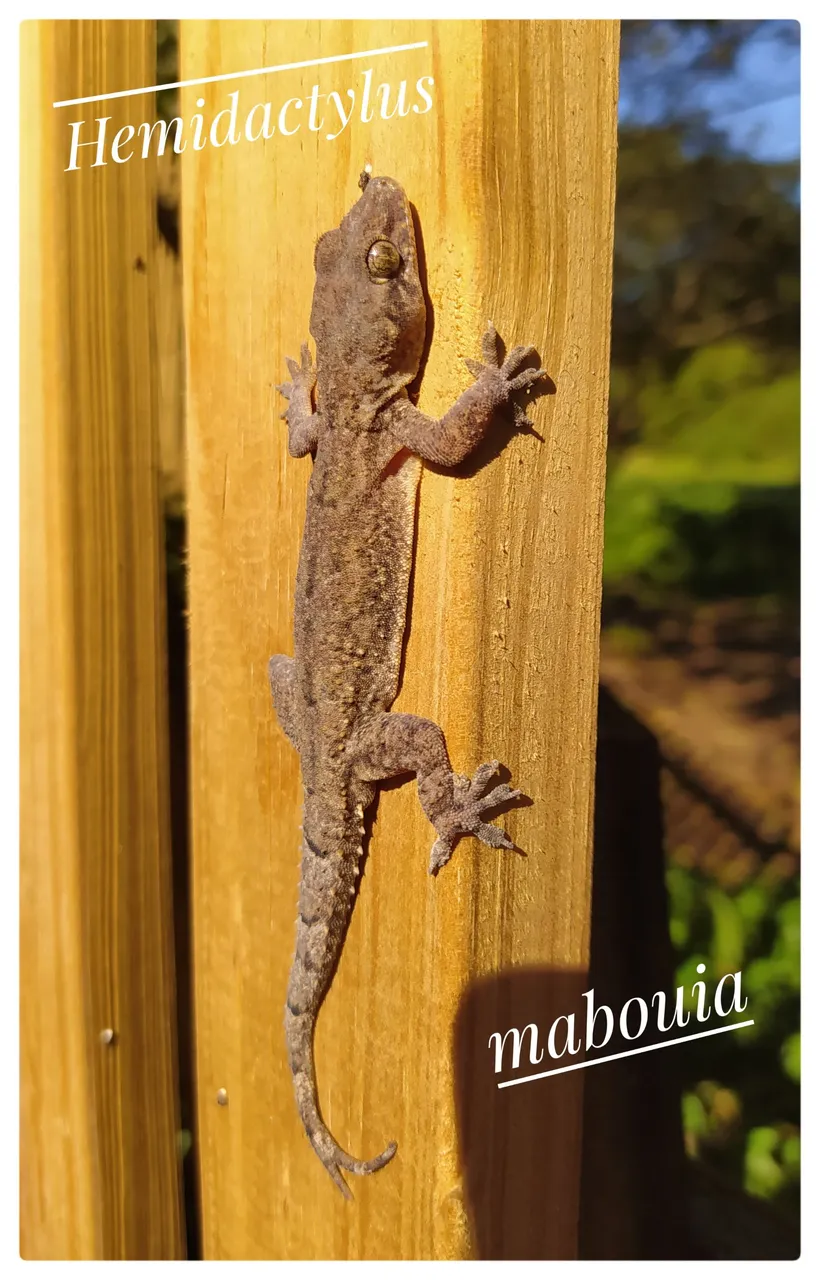
A few weeks prior I had packed wood on the side of the outside fireplace for when next we wanted to use it and I didn't bother checking it before setting the new fire alight close by. As things started to get warm and smokey, there was a mad flash and flurry of movement and I ran over to find this pretty gecko, faxed, confused and trying to escape. I relocated it and one of it's buddies to the fence line where it would be safe and didn't turn into a kebab.
It's one that I haven't found here before and I'm almost 100% certain that it's a Common Tropical House Gecko. The scientific name is Hemidactylus mabouia.
The genus name Hemidactylus, which comes from the Greek words hemisys or hemi meaning “half” and daktylos meaning “finger”, refers to the rows of skin folds under these geckos' digits, which are grouped in two halves.1
Did you know that Geckos are identified primarily by their toes? Similar to how our fingerprints are used. Confusing species' feet are scanned and then inspected to find the patterns that align with the correct species. I find that fascinating and learned it when I first started studying in University.
Geckos are by far one of my favourite animals. I have no idea why but I've always liked them. Around the world there are over a thousand different species. The fact that they can scale walls, trees, even flat smooth surfaces like windows sets them apart from many other species of reptiles.
This is a common species in my country, but it seems to be limited in range in the area that I'm in, perhaps they were introduced by the horticultural industry (quite a few species of geckos and frogs have been moved like this from gardens and plant nurseries), but it hasn't been confirmed from any of the sources I've scoured to learn more about this particular gecko.
You can see that this is a nocturnal2 species by it's pupil which is a vertical slit opposed to the diurnal3 species which generally have a round pupil. This particular gecko was about 17cm from snout to tail tip and didn't seem to mind me holding it to relocate it away from the fireplace. I found it interesting to note that it's tail is divided at the tip, this happens sometimes when a gecko loses it's tail, certain species have the ability to regrow them.
They use this as a survival mechanism. When threatened they will drop their tail which will writhe and wriggle for a few minutes after being shed as a way to attract a predator's attention while the gecko uses the decoy as an opportunity to escape. I am always very careful to not touch their tails when I have to capture one for relocation as this will most likely cause it to shed it and as I'm not actually a threat, it would be a horrible waste for the gecko as it would then have lost it's decoy and would have to spend energy and time regrowing a new one.
They are wonderful animals to have in your garden and around your house as they eat all manner of irritating insects like mosquitoes, flies and beetles.
I was very happy to find this guy and took the opportunity to snap a few mug shots for ID purposes. This one didn't seem to mind very much as it was soaking up the sunlight and would have later gone to find a new sleeping spot for the rest of the day. Whenever we find little critters like this, I give LL the opportunity to hold them if the animal is calm enough. I think it helps her to feel involved and close to the natural world. She's extremely gentle and talks soothingly to these little reptiles before they go on their way. She understands the difference between wild animals and pets and she's quite respectful of it. Of course she sometimes lets her excitement get the better of her and she wants to keep one, but I never let her and I think she will grow up with a good understanding of the reasons behind that.
Anyway, it was a nice encounter that ended with only braaied pork and not braaied gecko so I think being observant and quick on my feet helped. Next time though, I'll be sure to check the woodpile for any buddies before I light the fire.
1 Source
2 Nocturnal ~ active at night
3Diurnal ~ active during the day
Crepuscular ~ active at dawn and dusk
Other identification information was found in The Field Guide to Snakes and other Reptiles of Southern Africa by Bill Branch, 1994. Page 194 - 195.
@zeraton you have now done it. Every time that I want to use this template I feel guilty that I'm keeping people awake with Outdoorsy Andy OMG. I'm going to have to change it. 🤣
